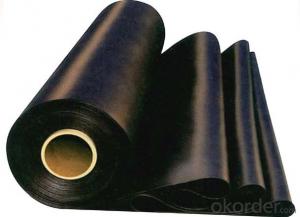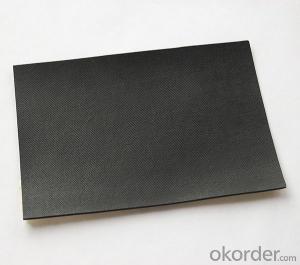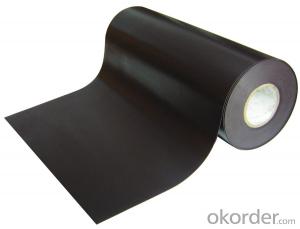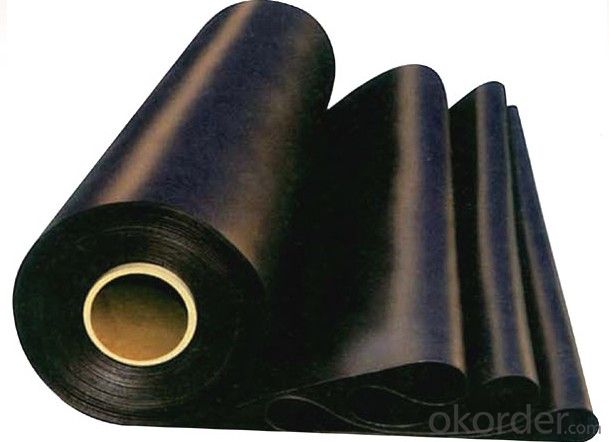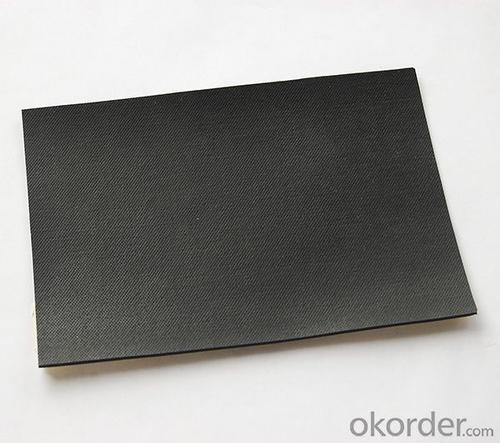EPDM High Polymer Waterproofing Membrane for Underground Roof
- Loading Port:
- China main port
- Payment Terms:
- TT OR LC
- Min Order Qty:
- 5000 m²
- Supply Capability:
- 100000 m²/month
OKorder Service Pledge
OKorder Financial Service
You Might Also Like
Introduction for EPDM Waterproofing Membrane:
It is a kind of self-adhesive waterproof coiled material based on polymer rubber and superior asphalt, together with polyethylene film and aluminum foil as surface material or no film(Double-sided self-adhesive). And it adopts the package preventing-adhesion-isolation-layer package, and dividing into no fiber and polyester fiber two parts.The coiled material has perfect performances, simple operation, non-pollution and etc.
Characteristic of EPDM Waterproofing Membrane:
1. High adhesive strength, durability, long after the bond;
2.Excellent weathering resistance, aging resistance;
3. Nano stabilizer added ingredients, low heat dimensional change;
4. High tensile strength, elongation, strong grass-roots stretching or cracking adaptability, resistance to low temperatures, can be adapted to -40 ℃;
5.Cold installation, easy to operate, reduce environmental pollution and improve working conditions of workers;
Specification of EPDM Waterproofing Membrane:
Item | Thickness(mm) | Width(mm) | Length(m) | Color |
1.0—2.0 | 1200 | 20 | Black | |
Deviation | -1 +15 | --1 | Multicolor |
FAQ of Waterproofing Membrane
a.Can we get some samples before place order?
Answer: We can send the free samples to you by freight collect.
b.How many years can your PVC membrane guarantee?
Answer: We will guarantee the quality for 5 years at least.
c.Which countries you ever export the product?
Answer: We export the PVC membrane to South Africa, Middle east and even European countries.
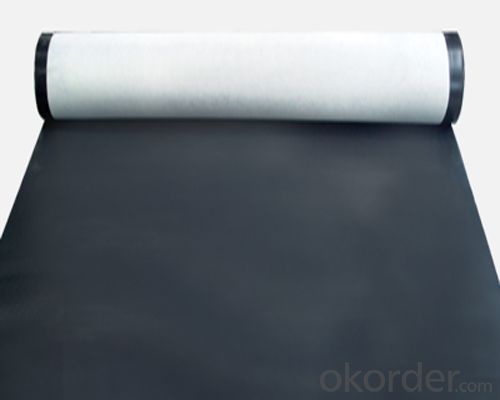
- Q: Can a waterproofing membrane be applied on both horizontal and vertical surfaces?
- Yes, a waterproofing membrane can be applied on both horizontal and vertical surfaces. Waterproofing membranes are designed to create a barrier that prevents water from penetrating through surfaces and causing damage. They are commonly used in various applications such as roofs, basements, bathrooms, and swimming pools. Whether it is a horizontal surface like a floor or a vertical surface like a wall, the waterproofing membrane can be applied to provide protection against water infiltration. The application process may vary depending on the specific surface, but there are membranes available that can be easily applied on both horizontal and vertical surfaces. It is important to follow the manufacturer's instructions and consult with professionals to ensure proper installation and effectiveness of the waterproofing membrane.
- Q: Does a waterproofing membrane require any specialized tools or equipment for installation?
- Yes, a waterproofing membrane typically requires specialized tools and equipment for installation. These may include items such as a trowel, roller, brush, or sprayer for application, as well as a heat gun or torch for properly sealing the seams. Additionally, some membranes may require specific adhesives or primers for proper attachment. It is important to consult the manufacturer's guidelines and instructions for the specific membrane being used to ensure proper installation.
- Q: Can a waterproofing membrane be used in planter boxes or raised beds?
- Yes, a waterproofing membrane can be used in planter boxes or raised beds to prevent water leakage and protect the surrounding structures. A waterproofing membrane is typically made of materials such as rubber, PVC, or polyethylene, which create a barrier between the soil and the surrounding area. This barrier helps retain moisture within the planter box or raised bed, preventing water from seeping into the ground and potentially causing damage to the foundation or nearby structures. Additionally, a waterproofing membrane can also prevent the leaching of chemicals or fertilizers from the soil, improving the overall quality of the planting environment. Nevertheless, it is important to ensure proper drainage in planter boxes or raised beds to prevent waterlogging and root rot.
- Q: Can a waterproofing membrane be used on stucco surfaces?
- Indeed, stucco surfaces can benefit from the application of a waterproofing membrane. Due to its porous nature, stucco has the ability to absorb water. Thus, the utilization of a waterproofing membrane can effectively deter water infiltration and consequential damage. Acting as a barrier, the waterproofing membrane hinders water from permeating the stucco and compromising the underlying structure. Furthermore, it safeguards the stucco from moisture-related complications like cracking, mold, and mildew. It is imperative to select a waterproofing membrane specifically designed for stucco surfaces and adhere to the manufacturer's instructions for proper installation. Moreover, routine inspections and maintenance of the waterproofing membrane are highly recommended to ensure its efficacy and durability.
- Q: Can a waterproofing membrane be used for bridge or tunnel waterproofing?
- Yes, a waterproofing membrane can be used for bridge or tunnel waterproofing. Waterproofing membranes are commonly used in construction projects to prevent water penetration and protect structures from potential damage caused by moisture. In the case of bridges and tunnels, which are exposed to harsh environmental conditions and high water pressure, a high-quality waterproofing membrane can effectively provide an impermeable barrier, ensuring the long-term durability and structural integrity of these infrastructure elements.
- Q: How long do waterproofing membranes typically last?
- Waterproofing membranes typically last between 10 to 20 years, depending on several factors such as the quality of the membrane, the installation process, and the level of maintenance and exposure to external elements.
- Q: Can waterproofing membranes be used on buried pipelines?
- Buried pipelines can benefit from the use of waterproofing membranes. These membranes are specifically designed to shield against water and moisture, and can be applied to a variety of surfaces, including buried pipelines. Typically, these membranes are constructed from materials like bitumen or synthetic polymers, which possess resistance to water penetration. When employed on buried pipelines, waterproofing membranes serve to prevent water infiltration, a process that can lead to corrosion and material deterioration. Acting as a barrier, they effectively halt water from reaching the surface of the pipeline, safeguarding it from potential moisture-induced harm. Furthermore, waterproofing membranes also offer protection against external elements like soil chemicals or gases, which may pose threats to the pipeline. By establishing a waterproof barrier, these membranes effectively extend the lifespan of buried pipelines, diminish maintenance expenses, and enhance overall performance. It is important to emphasize that the selection and application of waterproofing membranes should be entrusted to professionals who possess extensive knowledge in pipeline construction and waterproofing systems. Ensuring the effectiveness of these membranes requires proper installation techniques and compatibility with the pipeline material.
- Q: What is the resistance type SBS waterproofing membrane?
- The second is chemical resistance, in the waterproofing membrane production process, adding chemical resistance agent, similar to the chemical composition of herbicides, the plant roots are not close to the waterproofing membrane; In addition, copper ions have a similar effect.
- Q: Are waterproofing membranes resistant to punctures?
- Yes, waterproofing membranes are designed to be resistant to punctures. These membranes are typically made from durable materials such as polyvinyl chloride (PVC), thermoplastic olefin (TPO), or ethylene propylene diene terpolymer (EPDM), which are known for their strength and ability to withstand external pressures. Additionally, waterproofing membranes are often reinforced with polyester or fiberglass to further enhance their puncture resistance. However, it is important to note that while waterproofing membranes are designed to be highly resistant to punctures, they may still be susceptible to damage if subjected to sharp objects or excessive force. Therefore, it is essential to handle and install these membranes with care to maintain their integrity and effectiveness.
- Q: Can a waterproofing membrane be applied in cold weather conditions?
- Applying a waterproofing membrane in cold weather is possible, but the temperature range may differ depending on the product and manufacturer guidelines. Certain membranes can endure cold temperatures and be applied as low as -20 degrees Celsius (-4 degrees Fahrenheit), while others may have a higher minimum application temperature. Following the manufacturer's instructions is crucial, as well as ensuring the surface is adequately prepared and free from ice, snow, or moisture. Consulting with an experienced professional contractor who has worked with waterproofing membranes in cold weather conditions is also recommended for optimal results.
Send your message to us
EPDM High Polymer Waterproofing Membrane for Underground Roof
- Loading Port:
- China main port
- Payment Terms:
- TT OR LC
- Min Order Qty:
- 5000 m²
- Supply Capability:
- 100000 m²/month
OKorder Service Pledge
OKorder Financial Service
Similar products
Hot products
Hot Searches
Related keywords
